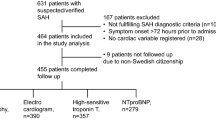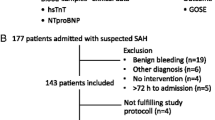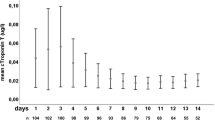Abstract
Background
Release of cardiac biomarkers is reported in patients with subarachnoid hemorrhage (SAH). Data addressing the impact of cardiac injury on outcome in these patients is sparse. This study was conducted to ascertain the association of elevation of serum cardiac Troponin-I (cTnI) with mortality and neurological outcome in patients with SAH.
Methods
Medical records of all patients admitted with a diagnosis of SAH and at least one measured cTnI were reviewed. Demographic and clinical variables including admission neurological status were collected. Conservative and non-parametric statistics were used to assess association between cTnI and death or neurological outcome at discharge.
Results
The study group comprised of 83 patients with a mean age of 59 years. There was a female (60%) and African-American (60%) preponderance. At admission, the median Glasgow Coma Scale (GCS) was 9, and 47% had a severe Hunt–Hess grade (HHG) of ≥4. Elevation of cTnI was found in 31 (37%) patients and was associated with worse baseline Fisher grade (p=0.01) and neurological status: GCS score (p=0.006) and HHG (p=0.007). Patients with abnormal cTnI were more likely to die (55% vs.27%; odds ratio 1.3–8.4, p = 0.01) and had a worse GCS score (p = 0.008) and HHG (p = 0.004) on discharge. On multivariate analysis, peak cTnI (p = 0.04) and admission GCS score of <12 (p = 0.02) were independent predictors of death at discharge.
Conclusion
Patients with subarachnoid hemorrhage and elevated cTnI are found to have worse neurological status at admission. These patients have a worse neurological outcome and in-hospital mortality.

Similar content being viewed by others
References
Marti-Fabregas J, Belvis R, Guardia E, Cocho D, Munoz J, Marruecos L, Marti-Vilalta JL. Prognostic value of Pulsatility Index in acute intracerebral hemorrhage. Neurology 2003;61(8):1051–6.
Zaroff JG, Rordorf GA, Newell JB, Ogilvy CS, Levinson JR. Cardiac outcome in patients with subarachnoid hemorrhage and electrocardiographic abnormalities. Neurosurgery 1999;44(1):34–9, discussion 39–40.
Sommargren CE, Zaroff JG, Banki N, Drew BJ. Electrocardiographic repolarization abnormalities in subarachnoid hemorrhage. J Electrocardiol 2002;35 Suppl:257–62.
Mayer SA, Fink ME, Homma S, Sherman D, Limandri G, Lennihan L, Solomon RA, Klebanoff LM, Beckford A, Raps EC. Cardiac injury associated with neurogenic pulmonary edema following subarachnoid hemorrhage. Neurology 1994;44(5):815–20.
Parekh N, Venkatesh B, Cross D, Leditschke A, Atherton J, Miles W, Winning A, Clague A, Rickard C. Cardiac troponin I predicts myocardial dysfunction in aneurysmal subarachnoid hemorrhage. J Am Coll Cardiol 2000;36(4):1328–35.
Deibert E, Aiyagari V, Diringer MN. Reversible left ventricular dysfunction associated with raised troponin I after subarachnoid haemorrhage does not preclude successful heart transplantation. Heart 2000;84(2):205–7.
Kono T, Morita H, Kuroiwa T, Onaka H, Takatsuka H, Fujiwara A. Left ventricular wall motion abnormalities in patients with subarachnoid hemorrhage: neurogenic stunned myocardium. J Am Coll Cardiol 1994;24(3):636–40.
Masuda T, Sato K, Yamamoto S, Matsuyama N, Shimohama T, Matsunaga A, Obuchi S, Shiba Y, Shimizu S, Izumi T. Sympathetic nervous activity and myocardial damage immediately after subarachnoid hemorrhage in a unique animal model. Stroke 2002;33(6):1671–6.
Zaroff JG, Rordorf GA, Ogilvy CS, Picard MH. Regional patterns of left ventricular systolic dysfunction after subarachnoid hemorrhage: evidence for neurally mediated cardiac injury. J Am Soc Echocardiogr 2000;13(8):774–9.
Zaroff JG, Rordorf GA, Titus JS, Newell JB, Nowak NJ, Torchiana DF, Aretz HT, Picard MH, Macdonald RL. Regional myocardial perfusion after experimental subarachnoid hemorrhage. Stroke 2000;31(5):1136–43.
Zaroff JG, Pawlikowska L, Miss JC, Yarlagadda S, Ha C, Achrol A, Kwok PY, McCulloch CE, Lawton MT, Ko N, Smith W, Young WL. Adrenoceptor polymorphisms and the risk of cardiac injury and dysfunction after subarachnoid hemorrhage. Stroke 2006;37(7):1680–5.
Fisher CM, Kistler JP, Davis JM. Relation of cerebral vasospasm to subarachnoid hemorrhage visualized by computerized tomographic scanning. Neurosurgery 1980;6(1):1–9.
Banki NM, Kopelnik A, Dae MW, Miss J, Tung P, Lawton MT, Drew BJ, Foster E, Smith W, Parmley WW, Zaroff JG. Acute neurocardiogenic injury after subarachnoid hemorrhage. Circulation 2005;112(21):3314–9.
Elrifai AM, Bailes JE, Shih SR, Dianzumba S, Brillman J. Characterization of the cardiac effects of acute subarachnoid hemorrhage in dogs. Stroke 1996;27(4):737–41, discussion 741–2.
Sato K, Masuda T, Izumi T. Subarachnoid hemorrhage and myocardial damage clinical and experimental studies. Jpn Heart J 1999;40(6):683–701 .
Di Angelantonio E, Fiorelli M, Toni D, Sacchetti ML, Lorenzano S, Falcou A, Ciarla MV, Suppa M, Bonanni L, Bertazzoni G, Aguglia F, Argentino C. Prognostic significance of admission levels of troponin I in patients with acute ischaemic stroke. J Neurol Neurosurg Psychiatry 2005;76(1):76–81.
Naidech AM, Kreiter KT, Janjua N, Ostapkovich ND, Parra A, Commichau C, Fitzsimmons BF, Connolly CS, Mayer SA. Cardiac troponin elevation, cardiovascular morbidity, and outcome after subarachnoid hemorrhage. Circulation 2005;112(18):2851–6.
Sakr YL, Ghosn I, Vincent JL. Cardiac manifestations after subarachnoid hemorrhage: a systematic review of the literature. Prog Cardiovasc Dis 2002;45(1):67–80.
Birns J, Sabharwal N, Senior R. Diagnosis of subarachnoid hemorrhage indicated by transthoracic echocardiography. J Am Soc Echocardiogr 2003;16(9):995–8.
Inoue F, Tsuzuki T, Thoma Y, Shiono S, Tabuse H, Hoshida T, Saito Y. Subarachnoid hemorrhage complicated with different manifestations of transient abnormal left ventricular wall motion: two case reports. J Cardiol 2006;47(5):245–54.
Author information
Authors and Affiliations
Corresponding author
Rights and permissions
About this article
Cite this article
Ramappa, P., Thatai, D., Coplin, W. et al. Cardiac Troponin-I: A Predictor of Prognosis in Subarachnoid Hemorrhage. Neurocrit Care 8, 398–403 (2008). https://doi.org/10.1007/s12028-007-9038-7
Published:
Issue Date:
DOI: https://doi.org/10.1007/s12028-007-9038-7




